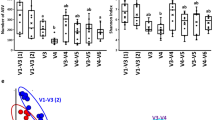Abstract
The purpose of this study was to detect three fibrolytic bacteria, Fibrobacter succinogenes, Ruminococcus flavefaciens, and Ruminococcus albus, in the cecal digesta of the ostrich (Struthio camelus) by PCR using a species-specific primer set for each 16S ribosomal RNA gene (16S rDNA). Although amplified DNA fragments obtained from each primer set had the expected size, the clone library derived from the amplimer contained non-specific sequences. The F. succinogenes-specific primer set recovered a partial 16S rDNA sequence of an uncultivated Fibrobacter with low similarity (<95%) and distantly related phylogenetic positioning to Fibrobacter sequences deposited in the databases, indicating a novel species of Fibrobacter. The sequence was considered to be identical to a clone detected in our previous experiment. Thus, we confirm that the gastrointestinal tract of the ostrich is one of the habitats of Fibrobacter species. The clone library derived from the R. flavefaciens-specific primer set contained a 16S rDNA sequence with 97% similarity to R. flavefaciens, indicating it could be one of a major fibrolytic bacterium in the ostrich ceca. No R. albus 16S rDNA sequence was found in the clone library of the R. albus-specific primer set.


Similar content being viewed by others
References
Altschul SF, Madden TL, Schäffer AA et al (1997) Gapped BLAST and PSI-BLAST: a new generation of protein database search programs. Nucleic Acids Res 25:3389–3402
Bennegadi N, Fonty G, Millet L et al (2003) Effects of age and dietary fibre level on caecal microbial communities of conventional and specific pathogen-free rabbits. Microb Ecol Health D 15:23–32
Frey JC, Rothman JM, Pell AN, Nizeyi JB, Cranfield MR, Angert ER (2006) Fecal bacterial diversity in a wild gorilla. Appl Environ Microbiol 72:3788–3792
Fukatsu T (1999) Acetone preservation: a practical technique for molecular analysis. Mol Ecol 8:1935–1945
Godon J, Zumstein E, Dabert D et al (1997) Molecular microbial diversity of an anaerobic digester as determined by small-subunit rDNA sequence analysis. Appl Environ Microbiol 63:2802–2813
Hattori K, Matsui H (2008) Diversity of fumarate reducing bacteria in the bovine rumen revealed by culture dependent and independent approaches. Anaerobe 14:87–93
Koike S, Kobayashi Y (2001) Development and use of competitive PCR assays for the ruminal cellulolytic bacteria: Fibrobacter succinogenes, Ruminococcus albus and Ruminococcus flavefaciens. FEMS Microbiol Lett 204:361–366
Koike S, Shingu Y, Inaba H et al (2000) Fecal bacteria in Hokkaido native horses as characterized by microscopic enumeration and competitive polymerase chain reaction assays. J Equine Sci 11:45–50
Larkin MA, Blackshields G, Brown NP et al (2007) Clustal W and Clustal X version 2.0. Bioinformatics 23:2947–2948
Lin C, Stahl DA (1995) Taxon-specific probes for the cellulolytic genus Fibrobacter reveal abundant and novel equine-associated populations. Appl Environ Microbiol 61:1348–1351
Matsui H, Kato Y, Chikaraishi T, Moritani M, Ban-Tokuda T, Wakita M (2009) Microbial diversity in ostrich ceca as revealed by 16S ribosomal RNA gene clone library and detection of novel Fibrobacter species. Anaerobe (in press)
McDonald JE, Lockhart RJ, Cox MJ, Allison HE, McCarthy AJ (2008) Detection of novel Fibrobacter populations in landfill sites and determination of their relative abundance via quantitative PCR. Environ Microbiol 10:1310–1319
Montgomery L, Macy JM (1982) Characterization of rat cecum cellulolytic bacteria. Appl Environ Microbiol 44:1435–1443
Montgomery L, Flesher B, Stahl D (1988) Transfer of Bacteroides succinogenes (Hungate) to Fibrobacter gen nov. as Fibrobacter succinogenes comb. nov. and description of Fibrobacter intestinalis sp. nov. Int J Syst Bacteriol 38:430–435
Saitou N, Nei M (1987) The neighbor-joining method: a new method for reconstructing phylogenetic trees. Mol Biol Evol 4:406–425
Schloss PD, Handelsman J (2005) Introducing DOTUR, a computer program for defining operational taxonomic units and estimating species richness. Appl Environ Microbiol 71:1501–1506
Swart D, Mackie RI, Hayes JP (1993) Influence of live mass, rate of passage and fibre digestion in the ostrich (Struthio camelus var. domesticus). S Afr J Anim Sci 23:119–126
Swart D, Mackie RI, Hayes JP (1993) Fermentative digestion in the ostrich (Struthio camelus var. domesticus), a large avian species that utilizes cellulose. S Afr J Anim Sci 23:127–135
Tajima K, Aminov RI, Nagamine T et al (2001) Diet-dependent shifts in the bacterial population of the rumen revealed with real-time PCR. Appl Environ Microbiol 67:2766–2774
van Gylswyk KO, Russouw T, James MD et al (1998) Bacterial cellulose degradation in the ostrich digestive tract. In: Ohmiya K, Hayashi K, Sakka K, Kobayashi Y, Karita S, Kimura T (eds) Genetics, biochemistry and ecology of cellulose degradation. Uni Publishers, Co. Ltd., Tokyo, Japan, pp 602–610
Varel VH, Fryda SJ, Robinson IM (1984) Cellulolytic bacteria from pig large intestine. Appl Environ Microbiol 47:219–221
Yamano H, Koike S, Kobayashi Y, Hata H (2008) Phylogenetic analysis of hindgut microbiota in Hokkaido native horses compared to light horses. Anim Sci J 79:234–242
Acknowledgments
The authors thank Professor Kazunari Ushida and his colleagues (Kyoto Prefectural University, Kyoto, Japan) for their instruction of DNA extraction. The present study was financially supported by Grants-in-Aid for Scientific Research, Japan Society for the Promotion of Science (17380157). Nucleotide sequencing was carried out at Life Science Research Center (Center for Molecular Biology and Genetics, Mie University (Tsu, Japan).
Author information
Authors and Affiliations
Corresponding author
Rights and permissions
About this article
Cite this article
Matsui, H., Ban-Tokuda, T. & Wakita, M. Detection of Fiber-Digesting Bacteria in the Ceca of Ostrich Using Specific Primer Sets. Curr Microbiol 60, 112–116 (2010). https://doi.org/10.1007/s00284-009-9513-9
Received:
Accepted:
Published:
Issue Date:
DOI: https://doi.org/10.1007/s00284-009-9513-9




